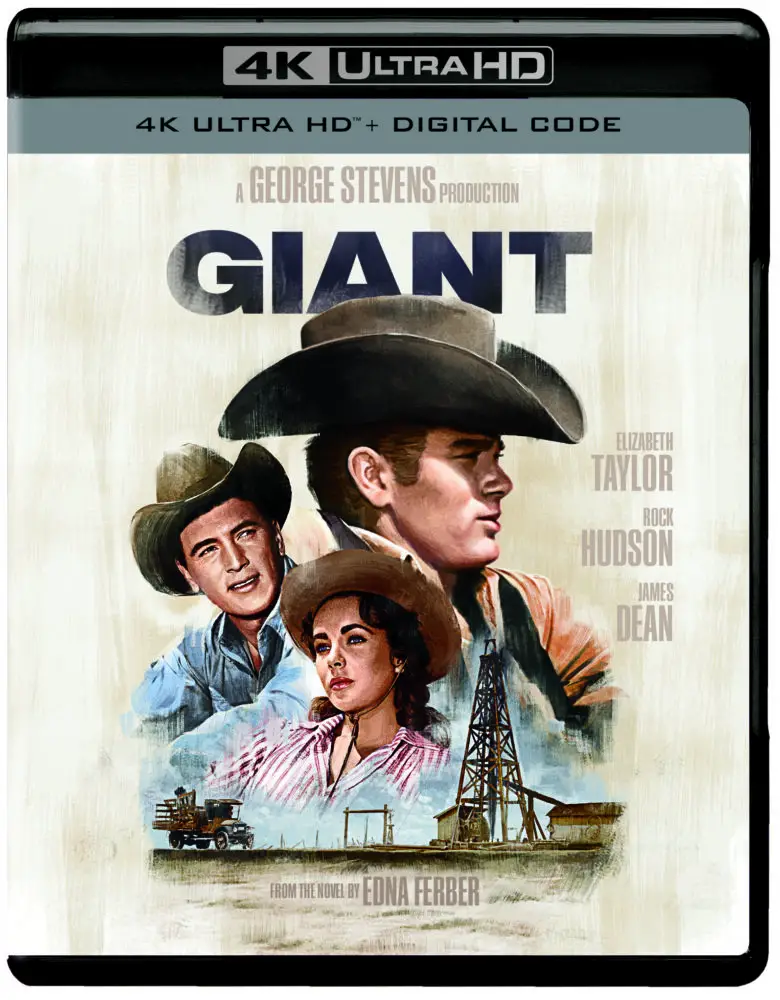I feel like James Dean is one of those Hollywood icons that deserves the completist treatment from cinephiles to fully experience and respect his aura and lasting legend. The best part is the homework, so to speak, for Dean is very easy, with only three credited films filling the to-do list (which stretches to eight if you dig for the uncredited stuff). The thickest hurdle of the three is the final one.
1956’s Giant, directed by George Stevens, is a daunting 197 minutes, compared to East of Eden and Rebel Without a Cause being under two-hours. Nevertheless, it’s an important step in the completion and appreciation process because you see best what could have been with James Dean and denser material. No to be outshined, we still get Elizabeth Taylor and Rock Hudson in their primes as well.
The film was released for the first time on the Ultra HD Blu-ray format on June 21st, and I was lucky enough to receive an advance copy. This was also my first ever time seeing the film, where this was my chance to complete the James Dean badge.

THE FILM
Dean takes his place in a love triangle between Rock Hudson and Elizabeth Taylor, a matinee megawatt appeal for its day. The trio star in a sweeping saga of jealousy, racism and the clash of cultures set in the vast Texas oilfields. Wealthy rancher Bick Benedict (Hudson) and dirt-poor cowboy Jett Rink (Dean) both woo Leslie Lynnton (Taylor), a beautiful young woman from Maryland who is new to Texas.
Leslie marries Benedict, but she is shocked by the racial bigotry of the White Texans against the local people of Mexican descent. Rink discovers oil on a small plot of land, and while he uses his vast, new wealth to buy all the land surrounding the Benedict ranch, Benedict’s disagreement over prejudice fuels conflict that runs across generations.
Considered by critics as ahead of its time, Giant is admired today for the breadth of its humanity more than its epic scale with its grand themes of generational conflict, racial tolerance, and social change. It exposed the marginalization and segregation of Mexican Americans for the first time on the big screen. At the center of the film, Elizabeth Taylor, as Leslie Benedict, portrays a strong and progressive woman who acts to stem the patterns of injustice.
Director George Stevens, Sr. won his second Oscar (after 1951’s A Place in the Sun, also starring Liz Taylor) for directing the sweeping family saga that feels like the size of Texas itself, set during the days of the oil boom. Giant was based on Edna Ferber’s controversial novel and garnered 10 total Academy Award nominations and an 8-fold return on its budget at the 1956 box office during its initial run. The film would go on to be selected for preservation by the Library of Congress in 2005.

THE DISC
The new 4K restoration for Giant was completed sourcing both the original camera negatives and protection RGB separation master positives for the best possible image. The audio was sourced primarily from a 1995 protection copy of the Original Magnetic Mono soundtrack. The picture and audio restoration was completed by Warner Bros. Post Production Creative Services: Motion Picture Imaging and Post Production Sound. For this first-time viewer, the visuals popped more than the sound.
The color was corrected in high dynamic range for the latest picture display technology. Cinematographer William C. Mellor, a two-time Oscar winning collaborator with Stevens (A Place in the Sun, The Diary of Anne Frank) really drank in the country as much as the characters. The striking vastness and high skies of the filming locations nearby Marfa, Texas never fail to impress. The same little town would go on to host There Will Be Blood and No Country for Old Men decades later to the same vista-heavy effect.
The lone special feature on the 4K disc is a commentary by George Stevens Jr., screenwriter Ivan Moffat and Los Angeles Film Critics Association member Stephen Farber. On that extensive audio track, Stevens is there to present his father’s perspective, and the admiration really shines through. Moffat’s insight, as the surviving witness, are the best nuggets, while the historian aim of Farber ties it all together. That’s it, though for a beefy movie.
The old 2-disc special edition DVD from 2005 included several documentaries and featurette on Stevens as a filmmaker, the film’s lavish premiere, and the historical legacy of the film. This is not the first Warner Bros. 4K release we’ve covered on 25YL to skimp on the little extra details, and there really is no excuse for disc space or package limitations. It reeks of fast-tracked laziness, especially if a fancier double-dip comes a few years later down the road. Films like Giant deserve better.



